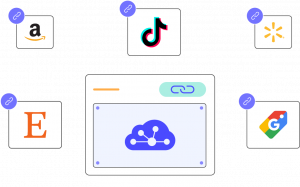If you’re searching for the best place to sell books online, you’re not alone. Whether you’re trying to find the best place to sell used books online, cash in on textbooks, or even locate the best place to sell comic books online, the right platform can make all the difference. Some sites specialize in rare collectibles, while others focus on quick sales for everyday titles.
In this guide, we’ll review 12 of the top platforms, explain how to sell your books effectively, and share tips to help you earn more.
How to choose the right platform:
- For new releases, bestsellers, self-publishing: Amazon is the default choice.
- For rare, collectible, or academic books: AbeBooks, eBay, or Etsy (for unique/vintage).
- For quick local sales: Facebook Marketplace, Half Price Books.
- For textbooks: Chegg, Barnes & Noble (trade-in), BookScouter, BookDeal.
- For bulk decluttering with low effort: Half Price Books.
- For secondhand, mass books or library-offloading: ThriftBooks.
- For creative/handmade/vintage books: Etsy.
- For community-driven casual selling: Pango Books.
Best Place to Sell Books Online: 12 Leading Sites
There are several top online marketplaces for selling new and used books. Each platform has its own advantages and disadvantages, so it’s worth exploring multiple options to find the best fit.
In short, where to sell books online? Here’s the summary:
Platform | Pros | Cons | Best for Selling |
Amazon | • Massive reach, global brand recognition | • High competition | Most book types, especially bestsellers, new releases, indie publishing, general used books |
eBay | • Lower fees | • Manual shipping & prepping | Used, collectible, rare, niche books; quick sales for unique volumes |
AbeBooks | • Best for rare, collectible, and academic books | • Monthly fee & commissions | Rare, collectible, academic, out-of-print books |
BookScouter | • Aggregates offers, compares prices | • Bulk only/Selected vendors | Used textbooks, bulk sales, price comparison for best pay-outs |
Facebook Marketplace | • Free listings | • No seller protection | Popular books, local used books, children's books, one-off sales |
ThriftBooks | • Wide selection of used books | • Shipping may be slow | Libraries, institutions bulk-selling collections; not for casual sellers |
Barnes & Noble | • Textbook trade-ins | • Smaller audience than Amazon | Textbooks, academic, print books, Nook ebooks |
Half Price Books | • Convenient drop-off & instant payment | • Low payouts per book | Bulk used books, mass decluttering, non-collectibles |
Chegg | • Easy textbook buyback & rental | • Only accepts textbooks | College textbooks, academic books |
Etsy | • Niche audience for vintage/handmade books | • Small audience | Vintage, handmade, art books, personalized journals, rare/unique editions |
BookDeal | • Free shipping | • Payout depends on final inspection | Used college textbooks, bulk textbook sales |
Pango Books | • Easy app-based listing | • 20% fee per sale | General used books, fiction/nonfiction, community sales |
1. Amazon – Massive reach, competitive market
Amazon is arguably the best place to sell books online if you want unmatched reach and visibility. With over 310 million active users and dominance in both print and e-book sales, it’s ideal for selling everything from bestsellers to indie titles. Whether you list books yourself or use Fulfilled by Amazon (FBA), the platform offers robust tools for sellers.
Selling fees & payout:
- 15% referral fee per book
- $0.99/item (Individual plan) or $39.99/month (Pro plan)
- $1.80 closing fee for books
- Additional FBA storage/fulfillment fees if used
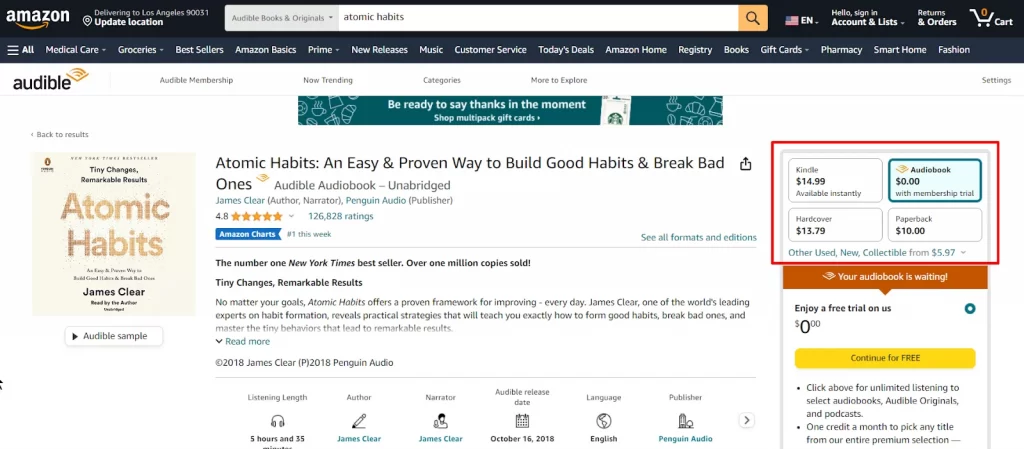
Pros:
✅ Massive reach (67% U.S. e-book market share)
✅ 300 million print books sold annually
✅ Easy listing process and powerful fulfillment options
✅ Suitable for any book type
Cons:
❌ High competition among sellers
❌ Fees can be significant
❌ Competitive pricing means more effort to stand out
Best for: Bestsellers and new releases, textbooks (print and digital), indie and self-published titles, sellers targeting a global audience
Tip for success: Price competitively, use Amazon’s keyword-rich listing tools, and consider FBA for faster delivery and Prime buyer visibility.
Do you find selling ebooks potential? Check out our ultimate guide on how to sell ebooks on Amazon.
Double Your Book Reach, Not Your Workload
Expand your reach without extra work. With LitCommerce, you can list your books across Amazon, eBay, Etsy, and more—while keeping your inventory in perfect sync. One tool, endless selling opportunities.
2. eBay – Auction-style and fixed-price listings
eBay is one of the best online places to sell books if you want complete control over pricing and listing style. With both auction and fixed-price options, it’s a trusted marketplace for secondhand, vintage, and collectible titles. Sellers can reach 134 million active buyers worldwide, making it a strong choice for niche and rare books.
Selling fees & payout:
- Final Value Fee: 10–15.55% of sale price
- $0.30 insertion fee after first 250 monthly listings
- Managed Payments fee: ~2.35–2.7% per transaction
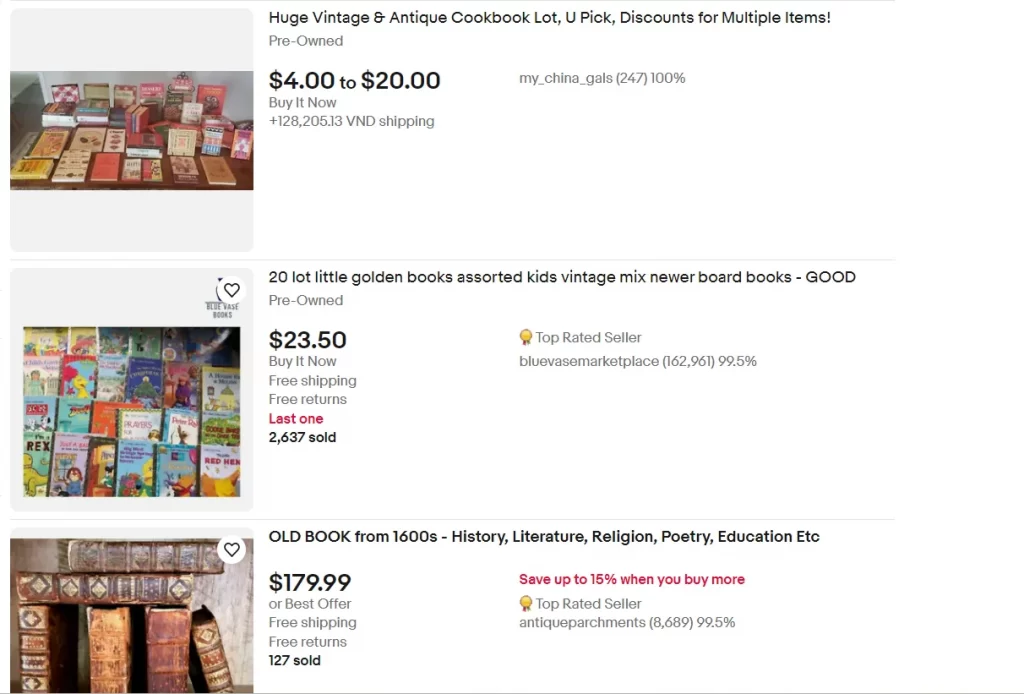
Pros:
✅ Flexible auction and fixed-price selling formats
✅ Full control over listings and pricing
✅ Well-known for secondhand and collectible items
Cons:
❌ Lower overall reach compared to Amazon
❌ Selling can be manual and time-intensive
Best for: Used and vintage books, rare or collectible editions, textbooks and academic materials, niche genres with passionate audiences
Tip for success: Highlight rarity or condition in titles, use multiple high-quality photos, and choose auction format for high-demand collectibles.
Learn more in our complete guide on how to sell on eBay to set up your listings, attract buyers, and maximize your book sales.
3. Abebooks – Great for rare and collectible books
If you’ve ever wondered where is the best place to sell books online that are rare, antique, or out-of-print, AbeBooks should be at the top of your list. Known for its highly curated audience, it connects sellers with serious collectors, academics, and bibliophiles worldwide. With over 110 million book listings, it’s ideal for titles that demand premium pricing.
However, some downsides accompany these benefits. Listing books requires a do-it-yourself setup rather than a direct selling platform. The site also prioritizes certain genres over others, like textbooks. Plus, navigating between book metadata like conditions and publishing details proves more convoluted than streamlined. You also have to pay a starting monthly fee of $25.
Selling fees & payout:
- Basic plan: No monthly fee; $1 per-item sale fee
- Volume sellers: $25–$500/month subscription
- Commission: 15% on first $500/item, 10% above
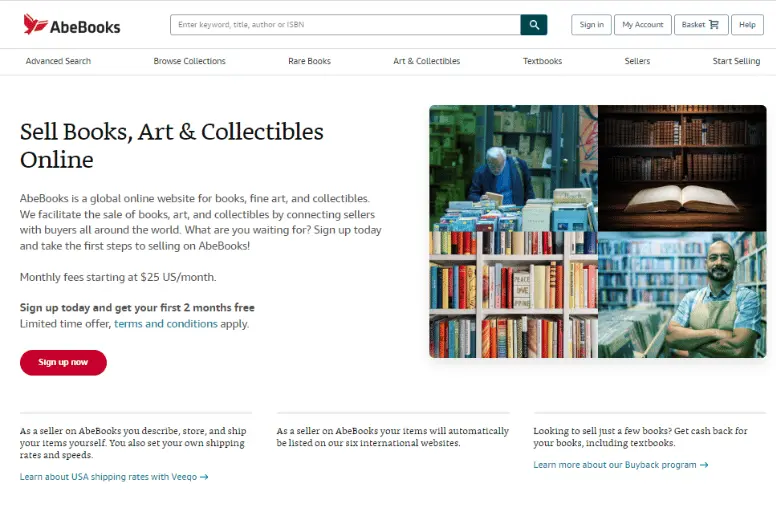
Pros:
✅ Highly regarded for rare and niche titles
✅ Global buyer base with focused interest
✅ Strong demand for high-value books
Cons:
❌ Monthly subscription cost for volume sellers
❌ Specialized audience means general books may sell slowly
Best for: Rare and collectible books, antiquarian and out-of-print editions, academic and scholarly works, signed or first editions
Tip for success: Provide detailed provenance and condition notes, include high-resolution images, and target niche keywords to attract collectors.
4. BookScouter – Compares offers from multiple book-buying websites
BookScouter is a powerful comparison tool and one of the best place to sell used books online if you want to maximize payouts. By scanning your book’s ISBN, you can instantly see buyback offers from dozens of vendors. It’s especially useful for selling used textbooks in bulk, ensuring you get the highest price without manually checking multiple sites.
Selling fees & payout:
- Free for users; vendor fees vary
- Payment methods depend on the vendor chosen

Pros:
✅ Aggregates offers from multiple book-buying sites
✅ Quick and easy price comparisons
✅ Ideal for maximizing profits on textbooks
Cons:
❌ Works only with participating vendors
❌ Limited to specific book types (mainly textbooks)
Best for: Used textbooks, bulk book lots, sellers who prioritize the highest buyback price
Tip for success: Scan multiple books at once, and choose vendors offering free shipping to increase net profits.
5. Facebook Marketplace – Local selling, no fees
If you’re asking which site is best for selling books without paying any fees, Facebook Marketplace is a strong contender. It connects you directly with local buyers, making it perfect for quick, in-person transactions. You can list books individually or in bundles, and your listings can reach thousands of potential buyers in your area.
Selling fees & payout:
- No platform fees
- Payment arranged directly with buyer (cash, bank transfer, etc.)
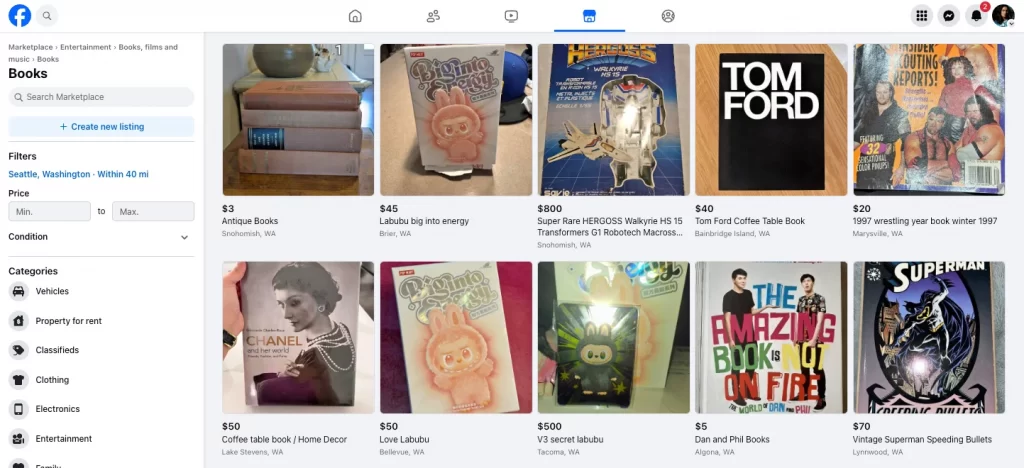
Pros:
✅ Zero seller fees
✅ Direct access to local buyers
✅ Fast, face-to-face transactions
Cons:
❌ No seller protection from scams
❌ Limited payment options
❌ Relies on local demand for sales
Best for: Popular used books with local demand, children’s books and educational sets, one-off or small-volume sales
Tip for success: Meet in public, use clear photos, and price slightly lower than online marketplaces to encourage fast local sales.
If you’re planning to list your books locally, our guide on How to Use Facebook for Business shows you how to create engaging listings, reach more buyers, and manage sales like a pro.
6. ThriftBooks – Popular for secondhand books
ThriftBooks is well-known among readers as a trusted source for affordable secondhand books, but it’s not necessarily the best place to sell used books online for casual individuals. Instead, the platform primarily works with bulk sellers like libraries, charities, and institutions looking to offload large volumes of books. Its eco-friendly approach ensures that millions of books are reused instead of being discarded.
Selling fees & payout: Not applicable to individual sellers; terms negotiated for bulk partners
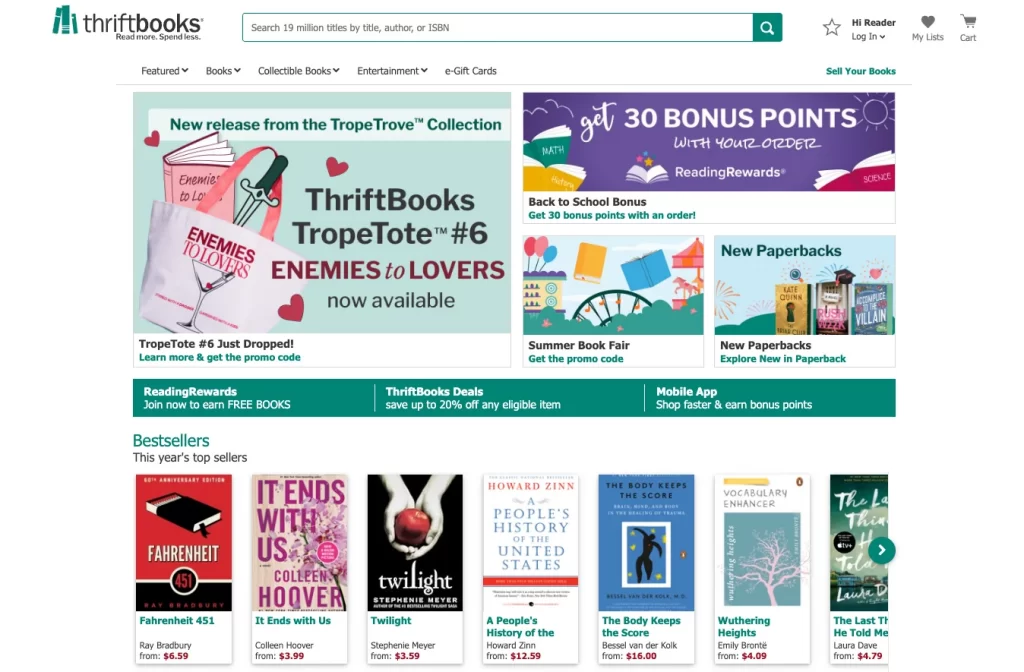
Pros:
✅ Massive selection and strong customer trust
✅ Eco-friendly focus on book reuse
✅ Established brand with a loyal buyer base
Cons:
❌ No direct listing option for individuals
❌ Primarily accepts bulk shipments from partners
Best for: Bulk sales from organizations or institutions, libraries and charities clearing inventory, sellers with consistent large-scale supply
Tip for success: If you have institutional quantities, contact ThriftBooks directly to discuss bulk selling arrangements and pricing.
7. Barnes & Noble – Textbook trade-in program
Barnes & Noble may not have the massive scale of Amazon, but it remains a respected name in the book industry. Its textbook trade-in program makes it a contender for the best place to sell books online for cash, especially if you’re looking to offload academic titles quickly. Sellers receive quotes upfront, and the process is straightforward, focusing mainly on textbooks, Nook eBooks, and select print books.
Selling fees & payout:
- Fees are built into trade-in quotes
- Payment via check or store credit

Pros:
✅ Reliable textbook trade-in program
✅ Strong brand reputation and trust
✅ Offers both print and eBook selling opportunities
Cons:
❌ Smaller audience compared to Amazon
❌ Limited options for individual sellers beyond textbooks
Best for: College textbooks and academic materials, nook eBook, general print books in good condition
Tip for success: Use the trade-in program near semester-end when textbook demand is highest to get better offers.
8. Half Price Books – In-store and online selling options
Half Price Books is a convenient option if you need to sell a large number of books fast. While it may not be the best online place to sell books for maximum profit, it offers quick in-person payouts at its retail locations. The chain accepts a wide variety of titles, from novels to cookbooks, and promotes eco-friendly book reuse by reselling or recycling what it buys.
Selling fees & payout:
- No direct fees; payout is the offer given in-store
- Payment made on the spot in cash or store credit
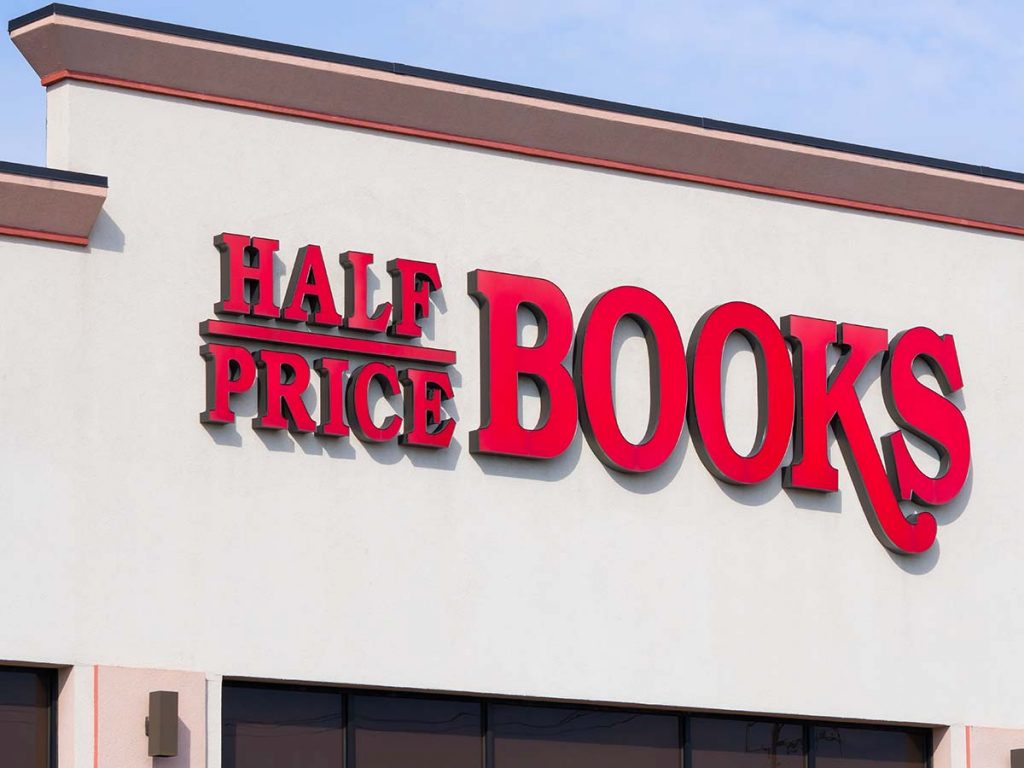
Pros:
✅ Fast, same-day payouts
✅ Accepts many different book categories
✅ Eco-friendly resale and recycling focus
Cons:
❌ Low payouts compared to online marketplaces
❌ No individual online listing options
❌ Pricing is not customized to book value
Best for: Quick bulk sales and decluttering, non-collectible general books, sellers who prefer in-person transactions.
Tip for success: Bring books in good condition and organize them by category to help staff process your lot faster.
9. Chegg – Ideal for textbook rentals and sales
Chegg is widely trusted by students for textbook rentals and buybacks, making it a strong candidate for the best place to sell your books online if those books are academic in nature. The platform focuses exclusively on textbooks, offering quick quotes, straightforward shipping, and fast payment once your books are received and approved.
Selling fees & payout:
- No direct selling fees; payout is built into the quote
- Payment via PayPal or check
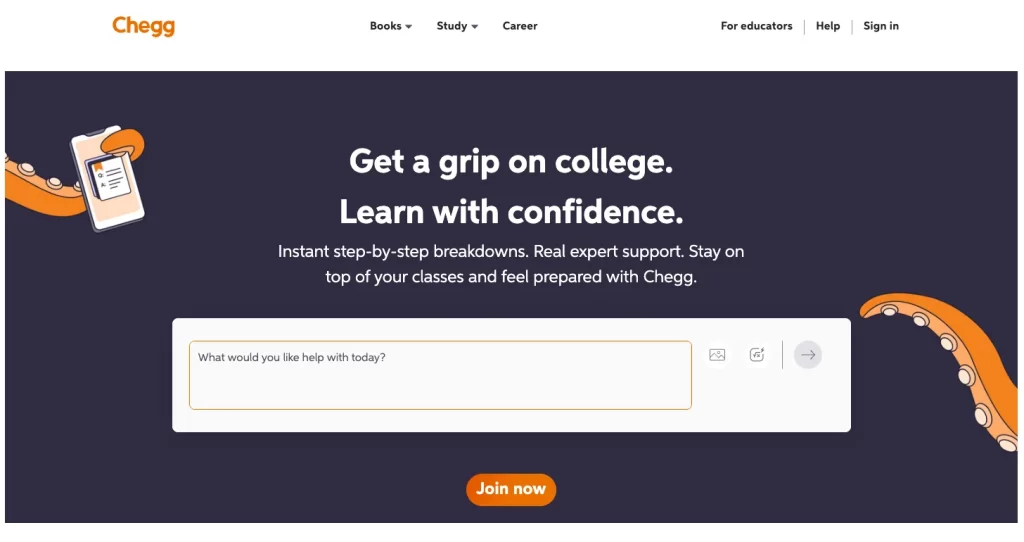
Pros:
✅ Simple textbook buyback and rental process
✅ Fast payment turnaround
✅ Trusted by students across the U.S.
Cons:
❌ Only accepts textbooks
❌ Strict acceptance based on condition and publisher list
Best for: College and university textbooks, recently published academic materials, sellers looking for quick transactions
Tip for success: Sell textbooks as soon as your course ends to get the best prices before new editions are released.
The Smarter Way to Go Multichannel
Thousands of sellers are growing faster with LitCommerce. List your books across multiple marketplaces like Amazon and eBay, manage everything in one place, and never oversell again.
10. Etsy – Best for vintage or handmade books
Etsy is one of the best place to sell books online if your titles are vintage, handmade, or uniquely artistic. The platform’s audience actively seeks one-of-a-kind items, from antique editions to personalized journals and artist-made books. Sellers have full creative control over their listings, presentation, and pricing, making it ideal for those who enjoy curating and marketing their work.
Selling fees & payout:
- $0.20 per listing
- 6.5% transaction fee
- Payment processing fee: ~3% + $0.25

Pros:
✅ Large, engaged audience for creative and unique items
✅ Ability to create fully customized listings
✅ Strong community of collectors and artisans
Cons:
❌ Niche audience limits broader book sales
❌ Requires active marketing and branding effort
❌ Best suited for non-mainstream book types
Best for: Vintage or antique books, handmade or personalized books, at books and rare editions
Tip for success: Use high-quality, styled photography and detailed descriptions to highlight the uniqueness and craftsmanship of each book.
If you have vintage or handmade books to sell, our step-by-step guide on How to Sell on Etsy for Beginners will help you set up your shop, attract the right buyers, and start making sales quickly.
11. BookDeal – Simple platform for selling textbooks and used books
BookDeal is a contender for the best place to sell books online if your inventory is mainly textbooks or select used books. The platform is designed for simplicity—enter your book’s ISBN, get an instant quote, ship for free, and get paid once your books pass inspection. It’s an excellent choice for sellers who want competitive offers without dealing with complex listing processes.
Selling fees & payout:
- No direct selling fees; quote includes platform margin
- Payment options include PayPal, Zelle, or check
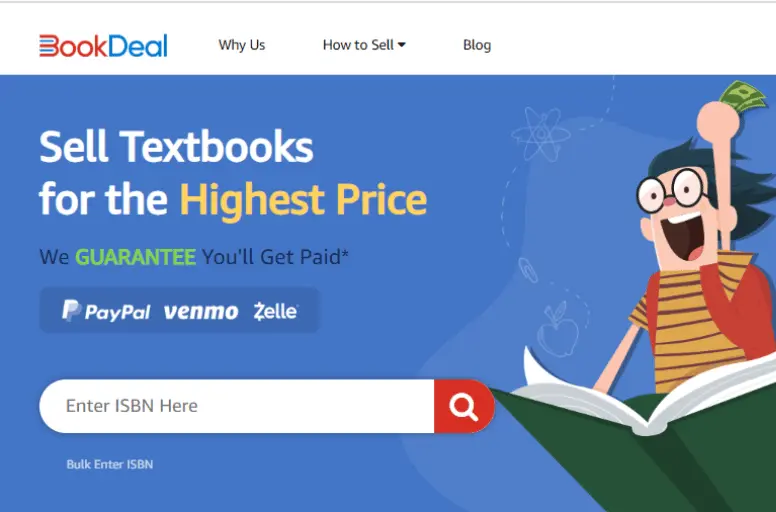
Pros:
✅ Easy-to-use interface for quick sales
✅ Free shipping included
✅ Competitive offers from buyers
Cons:
❌ Only accepts textbooks and limited used books
❌ Payout is subject to inspection results
Best for: Used textbooks, bulk textbook sales, sellers who prefer a fast, guided selling process
Tip for success: Ensure textbooks are in good condition with all supplemental materials to avoid payout reductions.
11. Pango Books – Community-driven book-selling app
If you’ve been asking yourself which site is best for selling books in a relaxed, community-focused way, Pango Books is a strong contender. Built as an easy-to-use mobile app, it lets you snap photos of your books, add simple details, and list them for sale in minutes. The platform’s buyer base is made up of avid readers who appreciate the direct, personal feel of peer-to-peer sales.
Selling fees & payout:
- 20% commission per sale
- Payout via direct deposit once the buyer confirms receipt

Pros:
✅ Simple, intuitive app interface
✅ Free to list with no upfront costs
✅ High seller payout — you keep 80% of each sale
Cons:
❌ 20% commission fee on every sale
❌ Pricing can be competitive within the community
Best for: General used books in good condition, casual or hobbyist sellers, sellers who prefer a mobile, on-the-go selling process
Tip for success: Take clear, well-lit photos, write concise but engaging descriptions, and price strategically to stand out in a growing marketplace of fellow book enthusiasts.
You might also like: 55 Easy Things to Make and Sell for Money – Profitable DIY Business Ideas
How to Sell Books Online: 7 Step-by-Step Guide
Selling books online—whether new, used, rare, or self-published- can be both a rewarding side hustle and a full-time business. Here’s a step-by-step guide to help you start strong and maximize your success in the book market.
Step 1: Decide what types of books to sell
Before you list anything, choose your focus. Will you sell used books from your shelves, brand-new titles from publishers, or rare collector’s editions? You can even create and sell your own books—whether self-published paperbacks, eBooks, or audiobooks.
Options include:
- Used or pre-owned books
- New books from wholesalers or publishers
- Rare, vintage, or collectible editions
- Self-published titles (print, eBook, or audio)
Pro Tip: Use tools like Amazon Best Sellers, Goodreads lists, and trending hashtags like #BookTok on TikTok to discover what’s in demand.
Step 2: Source your book inventory
Once you know your focus, it’s time to find inventory. Start close to home by clearing out your own shelves, then branch out to other sources.
Where to find books:
- Your personal library
- Wholesalers, publishers, or distributors (for new books)
- Library sales, estate sales, thrift shops, flea markets, auctions, and used bookstores (for used and rare books)
- Self-publishing platforms like Kindle Direct Publishing (for your own work)
Step 3: Choose the right selling platform(s)
The platform you choose will impact your reach, fees, and audience. Some sites cater to rare books, others to textbooks, and some offer general book sales.
Popular marketplaces include:
- Amazon: Works for all book types, including Kindle Direct Publishing for self-publishing.
- eBay: Great for used, rare, and niche books—offers auction or fixed pricing.
- AbeBooks: Best for rare, out-of-print, academic, or collectible books.
- Decluttr, BookScouter, Half Price Books: Ideal for fast, bulk sales (lower payouts).
- Chegg, BookDeal: Focus on textbooks and academic titles.
- Etsy: Perfect for vintage, handmade, or artistic/unique books.
- Facebook Marketplace: Local sales, zero fees, quick deals.
- Your own online store: Platforms like Shopify give you full control but require more marketing.
Step 4: Prepare and list your books
First impressions matter, even in the online book world. A potential buyer can’t physically flip through your book, so your listing needs to do the convincing.
Start with great photos—natural lighting works best. Capture the front cover, spine, back cover, and any special features like illustrations, autographs, or slipcases. If there’s wear or damage, photograph it honestly.
Then, write a clear, detailed description. Include the title, author, condition, edition, year published, ISBN, and any unique qualities. If it’s a collectible, mention its rarity or market value. Sprinkle in relevant keywords so your listing shows up in searches.
When it comes to pricing, do your research. Check what similar books are selling for on your chosen platform. Factor in condition, rarity, demand, and selling fees—plus shipping costs—to ensure you’re still making a profit.
Step 5: Set up shipping & fulfillment
A great sale can be ruined by poor packaging, so protect your books as if you’re shipping something fragile.
Use padded mailers for paperbacks and add cardboard inserts for hardcover books to prevent bending. Bubble wrap is your friend for high-value or collectible items.
Offer buyers different shipping options—some will happily pay more for faster delivery, while others prefer the cheapest route. Most marketplaces offer built-in shipping tools to make label printing easy. If you’re selling eBooks, set up instant digital delivery so buyers can get their purchase immediately.
Don’t forget your return policy. A simple, fair policy builds trust and can actually increase sales, as buyers know they have a safety net if the book isn’t as expected.
Step 6: Promote and market your listings
Listing a book is just the beginning. You also need to help people find it.
Start with SEO: include specific, descriptive keywords in your listing titles and descriptions. For example, “First Edition Jane Austen Pride and Prejudice – 1813 Facsimile” is far more searchable than “Old Book.”
Leverage social media platforms like Instagram, TikTok (#BookTok), Twitter, and Facebook to showcase your books. Share behind-the-scenes content, beautiful cover shots, and even short videos flipping through pages.
If you have a customer email list, use email marketing to alert subscribers about new arrivals, special discounts, or themed collections.
Want an extra boost? Run small, targeted ads on Amazon, Facebook, or Google. Start with a modest budget, then increase spending only if you see a return.
Step 7: Track, optimize & scale
Once you start selling, it’s time to get analytical. Track your sales to see which book categories, authors, or editions perform best. You might find that certain genres consistently sell faster, or that one platform outshines the rest in profitability.
Customer service is your secret weapon. Respond to messages quickly, resolve any issues politely, and thank buyers for their purchase. Encourage happy customers to leave reviews—these can boost your credibility and sales dramatically.
As you grow, refine your strategy. Double down on genres that work, test out new platforms, experiment with pricing strategies, or consider selling internationally to expand your customer base.
7 Tips for Selling Books Online Successfully
To stand out in 2026’s competitive online book market, you need more than just a few listings—you need a strategy. These expert tips will help you attract more buyers, sell faster, and increase your profits.
1. Know your audience & niche
Success starts with understanding who you’re selling to. Use Amazon Best Sellers, Goodreads, and TikTok’s #BookTok to track trending genres, themes, and authors.
Target your marketing toward the readers you know best. If you’re passionate about science fiction or rare historical texts, focus your efforts there—you’ll be able to speak their language and deliver what they want.
2. Prepare quality listings
Your listing is often a buyer’s first impression—make it count.
- Professional covers and titles: Whether it’s your own book or a resale, an appealing cover image and a clear title draw clicks.
- Honest, detailed descriptions: Include the author, edition, condition, and relevant keywords. A short, enticing blurb can help sell the story.
- High-quality photos: Show the cover, spine, back, and any unique features or imperfections so buyers know exactly what they’re getting.
3. Expand your reach & catalog
Don’t limit yourself to one platform. List across multiple sites, such as Amazon, eBay, Barnes & Noble, and Etsy, to reach different audiences.
More titles mean more opportunities. Sellers and authors with a wider catalog often see higher overall sales because they appear in more searches and attract repeat customers.
4. Optimize pricing & promotions
Price strategically by checking competitors’ listings for similar books in similar condition.
Run promotions to generate urgency. Think flash sales, “buy one, get one” offers, or discounted bundles. For textbooks and used books, use comparison tools like BookScouter to find the most profitable selling option.
5. Build an author platform & community
If you’re an author, create a simple website to showcase your work, collect emails, and direct traffic from different marketplaces into one hub.
Maintain consistent branding: use the same logo, style, and tone across all platforms, so buyers recognize you instantly.
Engage with readers on social media. Share reviews, behind-the-scenes peeks, and relevant hashtags to boost visibility.
6. Maximize visibility
SEO matters. Use targeted keywords in your titles and descriptions so your books appear in search results on marketplaces and Google.
Consider running targeted ads on Amazon, Facebook, or Google. Start with a small budget, test results, and scale what works.
Email marketing is another powerful tool; send regular updates with new releases, recommendations, or exclusive deals to keep readers engaged.
7. Foster trust & community
Fast shipping and clear return policies give buyers confidence.
Respond to questions quickly and professionally—friendly service can turn a one-time buyer into a repeat customer.
Encourage reviews from happy buyers. Positive feedback boosts your credibility and can directly influence new shoppers to purchase.
Best Place to Sell Books Online – FAQs
Where is the best place to sell books?
The best place depends on the type of books you’re selling. Amazon offers massive reach for all book types, while AbeBooks is ideal for rare or collectible titles. For local, no-fee sales, Facebook Marketplace is a strong choice.
Is it worth trying to sell books online?
Yes—if you choose the right platform and price competitively, selling books online can be profitable. Many sellers start with books they already own, then expand into sourcing popular or high-value titles.
How to sell books online effectively?
Take clear photos, write detailed descriptions, use keywords in your listings, and price competitively. List on multiple platforms to reach more buyers and run occasional promotions to boost sales.
What is the best place to sell comic books online?
eBay is a top choice for comic books thanks to its auction format and global audience. Etsy can work well for vintage or collectible comics, especially if they have artistic or unique value.
Start Selling Your Books Online Now!
There are many great options available for selling books online.
Websites like Amazon and BookScouter make it easy to list your used books and reach a huge audience of potential buyers. For rare or antique books, AbeBooks is an excellent place to find knowledgeable collectors.
No matter what types of books you have, with a little research, you can surely find the best place to sell books online and make some extra cash in the process.
Explore LitCommerce’s tool for effortless cross-platform book sales. Feel free to reach out for assistance anytime.


